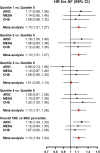Mitochondrial DNA copy number and incident atrial fibrillation
- PMID: 32933497
- PMCID: PMC7493408
- DOI: 10.1186/s12916-020-01715-6
Mitochondrial DNA copy number and incident atrial fibrillation
Abstract
Background: Mechanistic studies suggest that mitochondria DNA (mtDNA) dysfunction may be associated with increased risk of atrial fibrillation (AF). The association between mtDNA copy number (mtDNA-CN) and incident AF in the general population, however, remains unknown.
Methods: We conducted prospective analyses of 19,709 participants from the Atherosclerosis Risk in Communities Study (ARIC), the Multi-Ethnic Study of Atherosclerosis (MESA), and the Cardiovascular Health Study (CHS). mtDNA-CN from the peripheral blood was calculated from probe intensities on the Affymetrix Genome-Wide Human single nucleotide polymorphisms (SNP) Array 6.0 in ARIC and MESA and from multiplexed real-time quantitative polymerase chain reaction (qPCR) in CHS. Incident AF cases were identified through electrocardiograms, review of hospital discharge codes, Medicare claims, and death certificates.
Results: The median follow-up time was 21.4 years in ARIC, 12.9 years in MESA, and 11.0 years in CHS, during which 4021 participants developed incident atrial fibrillation (1761 in ARIC, 790 in MESA, and 1470 in CHS). In fully adjusted models, participants with the lowest quintile of mitochondria DNA copy number had an overall 13% increased risk (95% CI 1 to 27%) of incident atrial fibrillation compared to those with the highest quintile. Dose-response spline analysis also showed an inverse association between mitochondria DNA copy number and hazard for atrial fibrillation for all three cohorts. These associations were consistent across subgroups.
Conclusions: Mitochondria DNA copy number was inversely associated with the risk of AF independent of traditional cardiovascular risk factors. These findings implicate mitochondria DNA copy number as a novel risk factor for atrial fibrillation. Further research is warranted to understand the underlying mechanisms and to evaluate the role of mitochondria DNA copy number in the management of atrial fibrillation risk.
Keywords: Atrial fibrillation; Mitochondria DNA copy number; mtDNA.
Conflict of interest statement
The authors declare that they have no competing interests.
Figures



Similar articles
-
Association of lipoprotein-associated phospholipase A2 and risk of incident atrial fibrillation: Findings from 3 cohorts.Am Heart J. 2018 Mar;197:62-69. doi: 10.1016/j.ahj.2017.11.010. Epub 2017 Dec 5. Am Heart J. 2018. PMID: 29447785 Free PMC article.
-
Association of Mitochondrial DNA Copy Number With Cardiovascular Disease.JAMA Cardiol. 2017 Nov 1;2(11):1247-1255. doi: 10.1001/jamacardio.2017.3683. JAMA Cardiol. 2017. PMID: 29049454 Free PMC article.
-
Association between mitochondrial DNA copy number and sudden cardiac death: findings from the Atherosclerosis Risk in Communities study (ARIC).Eur Heart J. 2017 Dec 7;38(46):3443-3448. doi: 10.1093/eurheartj/ehx354. Eur Heart J. 2017. PMID: 29020391 Free PMC article.
-
Mitochondrial DNA copy number and diabetes: the Atherosclerosis Risk in Communities (ARIC) study.BMJ Open Diabetes Res Care. 2020 Aug;8(1):e001204. doi: 10.1136/bmjdrc-2020-001204. BMJ Open Diabetes Res Care. 2020. PMID: 32801120 Free PMC article.
-
Quantification of peripheral whole blood, cell-free plasma and exosome encapsulated mitochondrial DNA copy numbers in patients with atrial fibrillation.J Biotechnol. 2019 Jun 20;299:66-71. doi: 10.1016/j.jbiotec.2019.04.018. Epub 2019 May 4. J Biotechnol. 2019. PMID: 31063814
Cited by
-
Mitochondrial DNA Polymorphisms of Peripheral Blood Mononuclear Cells Associated with Sustained Ventricular Tachycardia in Patients with Cardioverter-Defibrillator Implantation Indications.Rev Cardiovasc Med. 2025 Mar 17;26(3):26744. doi: 10.31083/RCM26744. eCollection 2025 Mar. Rev Cardiovasc Med. 2025. PMID: 40160580 Free PMC article.
-
Genome-wide analysis of mitochondrial DNA copy number reveals loci implicated in nucleotide metabolism, platelet activation, and megakaryocyte proliferation.Hum Genet. 2022 Jan;141(1):127-146. doi: 10.1007/s00439-021-02394-w. Epub 2021 Dec 2. Hum Genet. 2022. PMID: 34859289 Free PMC article.
-
Somatic Mutations in Cardiovascular Disease.Circ Res. 2022 Jan 7;130(1):149-161. doi: 10.1161/CIRCRESAHA.121.319809. Epub 2022 Jan 7. Circ Res. 2022. PMID: 34995138 Free PMC article. Review.
-
A model to predict a risk of allergic rhinitis based on mitochondrial DNA copy number.Eur Arch Otorhinolaryngol. 2022 Oct;279(10):4997-5008. doi: 10.1007/s00405-022-07341-7. Epub 2022 Mar 29. Eur Arch Otorhinolaryngol. 2022. PMID: 35348857
-
Metabolic remodelling in atrial fibrillation: manifestations, mechanisms and clinical implications.Nat Rev Cardiol. 2024 Oct;21(10):682-700. doi: 10.1038/s41569-024-01038-6. Epub 2024 May 30. Nat Rev Cardiol. 2024. PMID: 38816507 Review.
References
-
- Mou L, Norby FL, Chen LY, O’Neal WT, Lewis TT, Loehr LR, Soliman EZ, Alonso A. Lifetime risk of atrial fibrillation by race and socioeconomic status: ARIC Study (Atherosclerosis Risk in Communities) Circ Arrhythm Electrophysiol. 2018;11(7):e006350. doi: 10.1161/CIRCEP.118.006350. - DOI - PMC - PubMed
-
- Chugh SS, Havmoeller R, Narayanan K, Singh D, Rienstra M, Benjamin EJ, Gillum RF, Kim YH, McAnulty JH, Jr, Zheng ZJ, et al. Worldwide epidemiology of atrial fibrillation: a Global Burden of Disease 2010 Study. Circulation. 2014;129(8):837–847. doi: 10.1161/CIRCULATIONAHA.113.005119. - DOI - PMC - PubMed
Publication types
MeSH terms
Substances
Grants and funding
- T32 GM007814/GM/NIGMS NIH HHS/United States
- R01 AG023629/AG/NIA NIH HHS/United States
- HHSN268201800001C/HL/NHLBI NIH HHS/United States
- HHSN268201200036C/HL/NHLBI NIH HHS/United States
- 16EIA26410001/AHA/American Heart Association-American Stroke Association/United States
- HHSN268201700004I/HL/NHLBI NIH HHS/United States
- P30 AG021334/AG/NIA NIH HHS/United States
- R01 HL111089/HL/NHLBI NIH HHS/United States
- HHSN268201700002I/HL/NHLBI NIH HHS/United States
- K24 HL148521/HL/NHLBI NIH HHS/United States
- HHSN268201700003I/HL/NHLBI NIH HHS/United States
- HHSN268201500003I/HL/NHLBI NIH HHS/United States
- R01 HL137259/HL/NHLBI NIH HHS/United States
- HHSN268200800007C/HL/NHLBI NIH HHS/United States
- UL1 TR000040/TR/NCATS NIH HHS/United States
- U01 HL130114/HL/NHLBI NIH HHS/United States
- HHSN268201700001I/HL/NHLBI NIH HHS/United States
- R01 HL105756/HL/NHLBI NIH HHS/United States
- HHSN268201700005I/HL/NHLBI NIH HHS/United States
- UL1 TR001079/TR/NCATS NIH HHS/United States
- R01 HL131573/HL/NHLBI NIH HHS/United States
- R01 HL141989/HL/NHLBI NIH HHS/United States
- R01 HL127659/HL/NHLBI NIH HHS/United States
- R01 HL116747/HL/NHLBI NIH HHS/United States

